


お知らせ Information
- 2017.11.16
沿革・経歴 History/Background

『潜伏キリシタン図譜』表紙イメージ
cover image
2018年7月、「長崎と天草地方の潜伏キリシタン関連遺産」のユネスコの世界遺産登録が実現しました。しかし、始動から1年余り経つ間に、代々地域で受け継がれてきた、いわゆる「隠れキリシタン」の信仰活動は時とともに失われつつあり、伝承者も少なくなってきました。日本の歴史、芸術文化の振興にも影響を与えた潜伏キリシタンの姿を調査、研究する中で、今、記録に残さなければという使命を感じ、2015年より自治体や団体、有識者への協力要請活動も行いプロジェクトの準備活動を始め、2016年12月20日に「潜伏キリシタン図譜プロジェクト実行委員会」を設立しました。長崎、天草に限らず国内に広がる潜伏キリシタンの記録をまとめ、日・英併記の1冊とし、国外へもその文化を発信。また、全国の大学を中心にシンポジウムや展示を通して、広く一般にもその歴史を伝えていきます。プロジェクト達成のために、資金調達活動も同時に行います。
In July 2018, “Hidden Christian Heritage Sites in Nagasaki and the Amakusa Region” were listed as world heritage cultural sites. In this context, although a year has elapsed since the commencement of promotional activities, yet the tradition of the religious activities of these so-called “Kakure Kirishitan (Hidden Christians),” which was inherited in these regions in the course of these generations, is being lost due to the passage of time, and the inheritors of these traditions too are declining in number. This committee was launched by individuals, who, after having studied and researched the tales of the Hidden Christians who had played such a momentous role both in the history of the Japanese nation and with regard to the promotion of art and culture, considered it a mission on their part to compile a record of their findings. Accordingly, in 2015 we sought the cooperation of municipalities, organizations, and experts, we commenced preparatory activities, and launched the “Hidden Christians Illustrated Reference Book Project Executive Committee,” on December 20, 2016. Our aim was to make this unique culture known around the nation and the world by compiling records of the Hidden Christians, not merely in Nagasaki and Amakusa but in all other areas of the nation as well, and thereby create a first-time publication, both in Japanese and in English. Additionally, we seek to transmit the history of these Hidden Christians by way of symposiums and exhibitions both for universities and for the general public, and concurrently undertake efforts aimed at raising funds for the project.
目的Purpose
16世紀の半ばにフランシスコ・ザビエルによって日本に伝えられたキリスト教は中世の多くの日本人の心をつかみ、一時は織田信長、豊臣秀吉にも受け入れられキリシタン大名が数多く登場しました。その後、禁教令によって日本のキリシタンに暗黒の時代が訪れます。そのような時代に数百年にわたって秘かにキリスト教の信仰を守りつづけてきた人々がいます。「かくれキリシタン」といわれる人々です。かくれキリシタン(以下 現在の呼称「潜伏キリシタン」)の存在は、キリスト教史の一部と考えられてきました。しかし、その存在に言及せずして日本の歴史を語ることは出来ません。潜伏キリシタンの信仰生活は日本人の精神の在りように触れるものだからです。それは、たとえば、遠藤周作の『沈黙』や長与善郎の『青銅の基督』といった文学作品にも見て取れます。日本のキリスト教は、「繁栄→弾圧→潜伏→復活」という波瀾の歴史を歩んできました。禁教期におけるキリスト教信者は、これまで「隠れキリシタン」と紹介されてきました。しかし、その信仰の形は様々です。また、明治時代に入って禁教が解かれた後の信者たちの信仰の形も、集落によって独自のものがあります。その呼び方も最近の研究により「潜伏」「かくれ」「はなれ」と使い分けされるようになりつつあります。
2018年には、長崎・天草地方の潜伏キリシタンが育んだ、宗教文化の伝統を物語る12の構成資産による世界遺産登録を目指しています。一方で、いわゆる「かくれキリシタン」の信仰活動は、伝承者の減少もあって失われつつあります。時と共に退化・風化してしまう日本の潜伏キリシタンの有形、無形の遺物や文化財を調査収集し、その姿を記録して後世に伝え、他に類を見ない一冊とします。併せてシンポジウムや展覧会を催し、日本の歴史を改めて検証するものです。
Christianity was conveyed to Japan in the middle of the 16th century by Francis Xavier, and the religion charmed the hearts of many Japanese people. For a while, prominent lords such as Oda Nobunaga and Toyotomi Hideyoshi approved of Christianity, and several Christian daimyos (feudal lords) appeared around the country, but in time the persecution of Christianity commenced, and this heralded the dark ages for Christians in Japan. Nevertheless though there did exist people who secretly adhered to their faith for several hundred years, and the existence of such people who were termed “Kakure Kirishitan (Hidden Christians),” and who are currently known as “Senpuku Kirishitan (Underground Christians),” is now conceded as constituting a part of Christian history. Indeed, no discussion is possible on the history of Japan that fails to mention their presence, since the pious and conscientious lives they led stirred the very core of Japanese spirituality. This is a fact verified in literary works such as the novel Silence by Shusaku Endo, or the screenplay Seido no Kirisuto (Christ in Bronze) by Yoshiro Nagayo. Christianity in Japan endured a gruesome past, a history that varied from prosperity to oppression, concealment, and revival. Those who managed to sustain their faith during the period of the ban were termed “Kakure Kirishitan.” They upheld their faith in a diversity of ways, and subsequent to the lifting of the ban in the Meiji Period, their lives took on a variety of unique forms in diverse communities. As an outcome of recent research distinct labels are now being used to refer to them, including “senpuku (underground),” “kakure (hidden),” and “hanare (isolated).”
AIn 2018, a total of 12 assets that provide us an account of the religious culture and tradition fostered by the Hidden Christians or so-called Kakure Kirishitan in Nagasaki and the Amakusa region, were nominated for listing as UNESCO World Heritage sites. Yet in the meantime, the culture of their religious activities is being lost, owing to fewer numbers of successors remaining in order to maintain their tradition. This project aims at studying, collecting, and documenting the tangible and intangible relics and cultural assets of the Hidden Christians in Japan, lest they decline and be consigned to oblivion with the passage of time. This is done in order that they may be passed on to future generations. At the same time however symposiums and exhibitions will be organized, in order to shed new light on the history of the country.
本プロジェクトの活動Activities in the Project
-
2018年の世界遺産登録を目指す「長崎と天草地方の潜伏キリシタン関連遺産」活動のサポートをします。
Supporting the activities for the listing of “Hidden Christians Heritage Sites in Nagasaki and the Amakusa Region ” as a UNESCO World Heritage site in 2018.
-
日本のキリスト教が500年近い歴史の中で育んできた遺物・文化財を鳥瞰し、日本人とは何者なのか、その「精神史」を探ります。
Providing an overview of the relics and cultural assets that were fostered by Christianity in Japan over a period of nearly 500 years to question the identity of the Japanese people and their “spiritual history.”
-
日本各地に残されたキリスト教(キリシタン)の遺物・文化財のデータベース化を図り、日本の歴史・文化に関わる研究の発展へ寄与します。
Compiling a database of Christian relics and cultural assets that have been preserved in various regions around Japan to contribute to research on Japanese history and culture.
-
「図譜」の制作の過程で新たに発見した史料を題材に天草・長崎・畿内・東京・仙台・北海道でのシンポジウムの開催と資料展示会の開催。
Conducting symposiums and exhibitions in Amakusa, Nagasaki, Kinai, Tokyo, Sendai and Hokkaido, based on historical materials that were discovered in the process of compiling the “Illustrated Reference Book.”
遺物の状況The Present State of the Relics
日本のキリシタンの遺物・文化財は、300年近く続いた厳しいキリシタン弾圧の嵐の中でも絶えることなく現代に伝えられてきました。長崎、天草、平戸、島原、五島列島など九州を中心に、山口、大阪府茨木市などの畿内、東京、仙台、山形など全国各地に遺されています。
Christian relics and cultural assets have been preserved in Japan despite the persecution of Christians that raged through the country for nearly 300 years. Today, they can be found mainly in Kyushu, in areas including Nagasaki, Amakusa, Hirado, Shimabara and the Goto Islands as well as other regions around the country such as Yamaguchi, Kinai in Ibaraki City, Osaka Prefecture, Tokyo, Sendai and Yamagata.

切支丹鍔
熊本県天草市・天草キリシタン館
Christian sword guard
Amakusa Christian Museum in Amakusa City, Kumamoto Prefecture

マリア観音像
熊本県天草市・天草キリシタン館
Maria Kannon
Amakusa Christian Museum in Amakusa City, Kumamoto Prefecture

青銅製筒と木製キリスト磔刑像
大阪府茨木市
Bronze cylinder and wooden crucifix
Ibaraki City, Osaka Prefecture

メダイ 表・裏
熊本県天草市・天草キリシタン館
Medal (front and back)
Amakusa Christian Museum in Amakusa City, Kumamoto Prefecture
「図譜」構成概要
Outline of the Proposed Composition of the Illustrated Reference Book
- ローマ教皇メッセージ。
- 上智大学、東京国立博物館、長崎歴史博物館、澤田美喜記念館、島原城キリシタン史料館、日本二十六聖人記念館、平戸市切支丹資料館、茨木市立キリシタン遺物史料館などが所蔵する日本各地の遺物・文化財・史料などを中心におよそ1,500点を図譜に収録、解説を付記。
- 小史「日本におけるキリスト教(キリシタン)」。
- 解説「潜伏キリシタン・隠れキリシタン・復活とはなれ」。
- 世界遺産登録を目指す長崎市 佐世保市 平戸市 五島市 南島原市 小値賀町 新上五島町 天草市の教会群など。
- キリシタン大名の素顔とその周辺(高山右近、大村純忠、有馬晴信、支倉常長など)
-
Message from the Pope
-
Approximately 1,500 items consisting mainly of relics, cultural assets and historical documents in various locations around Japan will be included in the Illustrated Reference Book with commentaries. The items are owned by Sophia University, Tokyo National Museum, Nagasaki Museum of History and Culture, Miki Sawada Memorial Museum, Shimabara Castle Christian Archives Museum, Twenty-Six Martyrs Museum, Hirado Kirishitan Museum, Ibaraki Municipal Christian Heritage Museum and others.
-
Short history on “Christianity (Christians) in Japan.”
-
Commentary on “Senpuku Kirishitan (Underground Christians), Kakure Kirishitan (Hidden Christians), Revival and Isolation.”
-
Churches and Christian sites in Nagasaki City, Sasebo City, Hirado City, Goto City, Minamishimabara City, Ojika-cho, Shinkamigoto-cho and Amakusa City, which are nominated for listing as a UNESCO World Heritage.
-
Profiles of Christian daimyo (feudal lords) and the people around them (Takayama Ukon, Omura Sumitada, Arima Harunobu, Hasekura Tsunenaga, etc.)

マリア十五玄義図(東家本) 大阪府茨木市
“The Madonna and Her Fifteen Mysteries”/Higashi family version
Ibaraki City, Osaka Prefecture

ロレート聖母子像 大阪府茨木市
“The Madonna of Loreto”
Ibaraki City, Osaka Prefecture
シンポジウム・展示会
Symposiums/Exhibitions
「図譜」の作成、過程において発見した遺物の紹介。収録した遺物の再検証。収録、発見した史料(資料)の展示。
天草、東京、長崎、京都、仙台、北海道 2017年11月~2018年11月順次開催。
Introduction of the relics discovered in the process of compiling the Illustrated Reference Book. Reexamination of the relics included in the Illustrated Reference Book. Display of historical documents (materials) discovered or included in the Illustrated Reference Book
Amakusa, Tokyo, Nagasaki, Kyoto, Sendai, Hokkaido
To be held in order from October 2017 to November 2018.
潜伏キリシタン図譜プロジェクト
実行委員
Hidden Christians Illustrated Reference Book Project Members (tentative)
委員長 Chairman
髙祖敏明(聖心女子大学学長)[発行人]
Toshiaki Koso (President, University of the Sacred Heart) [Publisher]
副委員長 Vice Chairman
伊藤玄二郎(星槎大学教授)[編集人]
Genjiro Ito (Professor at Seisa University) [Editor in Chief]
上野景文(元駐バチカン大使)[渉外担当]
Kagefumi Ueno (former Ambassador to the Holy See) [in charge of public relations]
委員 Members
片岡瑠美子(長崎純心大学学長)
Rumiko Kataoka(President, Nagasaki Junshin Catholic University)
菊地 功(東京教区大司教)
Isao Kikuchi(Archbishop of Tokyo)
近藤誠一(元文化庁長官)
Seiichi Kondo(Former Director, General Agency for Cultural Affairs)
髙見三明(長崎教区大司教)
Mitsuaki Takami(Archbishop of Nagasaki)
長﨑輝章(元駐バチカン大使)
Teruki Nagasaki(Former Ambassador of Japan to the Holy See)
西田恵子(澤田美喜記念館館長)
Keiko Nishida (Director, Sawada Miki Memorial Museum)
濱口敏行(ヒゲタ醤油株式会社相談役)
Toshiyuki Hamaguchi (Executive Adviser, Higeta Shoyu Co. Ltd.)
ペドロ・カナヴァロ(パッソスカナヴァロ財団理事長)
Pedro Canavarro(President of the Passos Canavarro Foundation)
前田万葉(カトリック教会枢機卿)
Manyo Maeda(Cardinal of the Catholic Church)
宮澤保夫(星槎グループ会長)
Yasuo Miyazawa(Founder / CEO, SEISA Group)
村田興文(インナーブレイン株式会社代表取締役)
Okifumi Murata(Representative Director, Innerbrain,KK)
山折哲雄(宗教学者)
Tetsuo Yamaori (Scholar of Religion)
レンゾ・デ・ルカ(イエズス会日本管区長)
Renzo de Luca(Provincial, Japan Province, Society of Jesus)
*50音順 In Japanese alphabetical order
編集委員Editorial Committee Members
伊藤玄二郎(星槎大学教授)
Genjiro Ito (Professor, Seisa University)
上野景文(杏林大学特任教授、元駐バチカン大使)
Kagefumi Ueno (Specially-Appointed Professor at Kyorin University, former Ambassador to the Holy See)
小川早百合(聖心女子大学 国際交流学科教授)
Sayuri Ogawa (Professor of Comparative Culture at the University of the Sacred Heart, Tokyo)
柿森和年(阿古木隠れキリシタンの里)
Kazutoshi Kakimori (Akogi Kakure Kirishitan no Sato <Akogi Village of Hidden Christians>)
片岡瑠美子(長崎純心大学学長)
Rumiko Kataoka (President of Nagasaki Junshin Catholic University)
久米雅雄(大阪芸術大学客員教授)
Masao Kume (Affiliate Professor at the Osaka University of Arts)
髙祖敏明(上智大学理事長)
Toshiaki Koso (Chancellor of Sophia University)
五野井隆史(東京大学名誉教授)
Takashi Gonoi (Professor Emeritus at the University of Tokyo)
濱田直嗣(宮城県慶長使節船ミュージアム館長 元仙台市博物館長)
Naotsugu Hamada (Director of the Sant Juan Bautista Museum in Miyagi Prefecture, former Director of the Sendai City Museum)
平田豊弘(天草市世界遺産推進室)
Toyohiro Hirata (Amakusa City World Heritage Promotion Office)
山口道孝(横浜教区司祭)
Michitaka Yamaguchi (parish priest in Yokohama)
*50音順 In Japanese alphabetical order
協力Cooperation
協力(予定) Cooperation (tentative)
長崎県、熊本県、長崎市、佐世保市、平戸市、五島市、南島原市、小値賀町、新上五島町、天草市、茨木市、大磯町、東京国立博物館、京都大学、上智大学、星槎大学
Nagasaki Prefecture, Kumamoto Prefecture, Nagasaki City, Sasebo City, Hirado City, Goto City, Minamishimabara City, Ojika-cho, Shinkamigoto-cho, Amakusa City, Ibaraki City, Oiso-machi, Tokyo National Museum, Kyoto University, Sophia University, Seisa University
協賛Sponsors
株式会社NTT DATA
NTT DATA Corporation
三菱商事株式会社
Mitsubishi Corporation
公益財団法人 野村財団
Nomura Foundation
JT
Japan Tobacco Inc.
鎌倉大仏殿高徳院
Kotoku-in
澤田美喜記念館
清水建設株式会社
SHIMIZU CORPORATION
西日本洋行
キムラ・コーポレーション
ケイプラス
innerbrain株式会社
大河原 毅
濱口 敏行
伊藤 武














